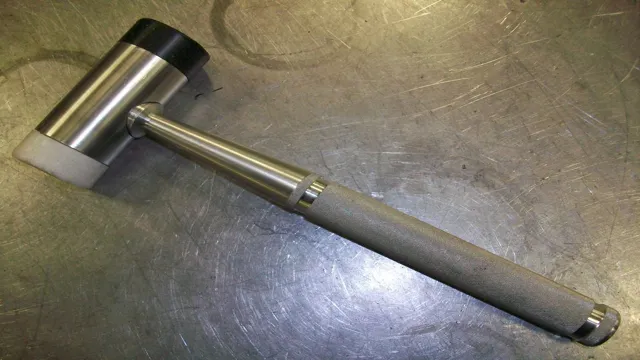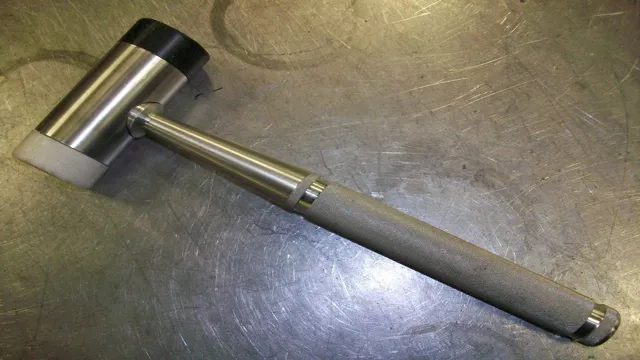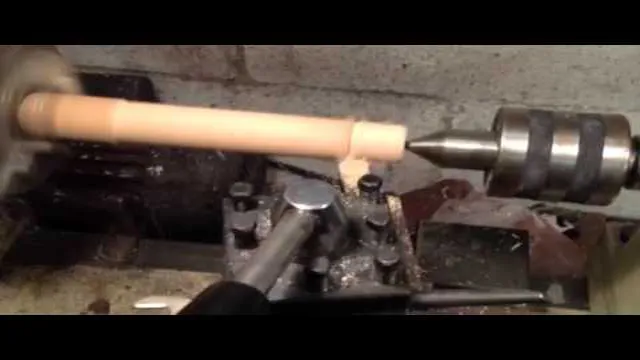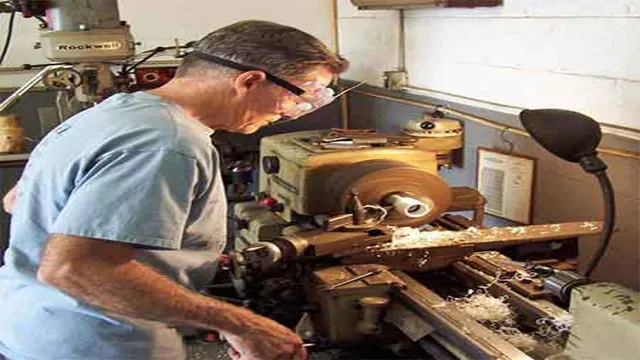Can You Use a Metal Lathe for Wood Turning? Learn the Pros and Cons!
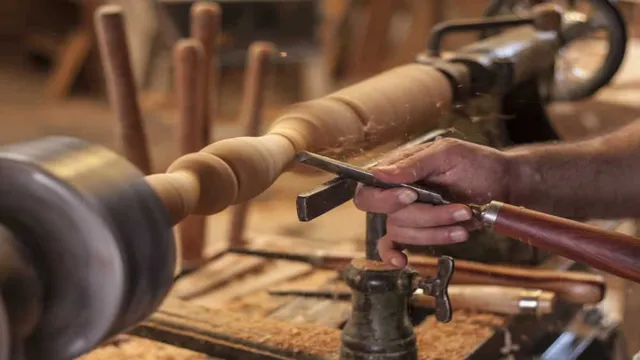
If you’re a woodturner who wants to expand their turning options, you may be wondering if a metal lathe can be used for woodturning. The answer is yes, but it’s not as simple as just switching out the metal tools for wood ones. While a metal lathe has many of the components needed for woodturning, there are crucial differences in the design and setup of metal and wood lathes that must be accounted for.
In this blog, we’ll dive into the details of using a metal lathe for woodturning and explore the steps you need to take to get started. Let’s begin!
Understanding the Differences Between a Metal Lathe and Wood Lathe
Both metal lathes and wood lathes are designed to shape materials using a spinning motion, but they are not interchangeable. While it is possible to use a metal lathe for wood turning, it is not necessarily recommended. Metal lathes are built to handle harder materials, which means they spin faster and have more powerful motors.
This can be dangerous when working with softer woods, as the speeds can lead to splintering or shattering. Additionally, metal lathes typically have smaller chucks and less tailstock travel, limiting the size of the workpiece that can be turned. On the other hand, wood lathes are specifically designed for turning wood and have larger chucks and more tailstock travel, making them better suited for larger projects.
While there are some similarities between the two machines, it is important to use the correct type of lathe for the material being turned to ensure safety and optimal results.
Construction and Design
If you’re new to woodworking or metalworking, understanding the differences between a metal lathe and a wood lathe is crucial. In simple terms, a metal lathe is designed specifically for cutting metal while a wood lathe is used to shape wood into different designs. Each type of lathe has different components and is operated in a unique manner.
A wood lathe is best suited for creating curved or rounded shapes in wood. It has a motor and a cutting tool that help carve the shape of the wood. Instead of spinning the workpiece on the lathe, the cutting tool is used to shape it.
A metal lathe, on the other hand, uses a stationary cutting tool that moves across the spinning workpiece to remove material. Additionally, a metal lathe is built much differently than a wood lathe. It is typically made from heavy-duty materials to withstand the pressure of cutting metal.
Metal lathes also have a range of controls and dials to adjust the cutting speed and feed rate, allowing for precise cuts. Wood lathes, on the other hand, are generally lighter weight and less complex, making them perfect for beginners. In conclusion, whether you choose a metal lathe or a wood lathe will depend on the type of material you want to work with and the kind of projects you want to create.
Both have their own unique features and advantages, so it’s important to carefully consider your needs before making a purchase.

Speed Range
When it comes to woodturning and metalworking, one of the key differences between the two is the speed range of the lathe. Typically, metal lathes have a wider range of speeds compared to wood lathes. This is because metal needs to be cut at much slower speeds, while wood can be turned at higher speeds without damaging the material.
Metal lathes can reach speeds as low as 20 RPM and as high as several thousand RPM, while wood lathes usually operate between 500 and 4000 RPM. The difference in speed range is due to the fact that metal is much harder and denser than wood. As a result, cutting speed needs to be slower to avoid overheating the material, which can result in damaging the tool or the workpiece.
Conversely, wood can be more easily shaped at higher speeds, allowing for faster, more efficient removal of material. Understanding the differences between a metal lathe and wood lathe’s speed range is crucial, as it directly affects the type of projects and material you can work with.
Tool Rest and Tailstock
When comparing a metal lathe to a wood lathe, one of the key differences between the two is the tool rest and tailstock. While both types of lathes use similar parts, they are designed with different materials and purposes in mind. Tool rests and tailstocks on metal lathes are typically made of durable steel or iron and are designed for heavy-duty work.
They allow for precision cutting and shaping of metal, which often involves high-speed operation and intense pressure. On the other hand, tool rests and tailstocks on wood lathes are typically made of lighter materials like aluminum or cast iron, and are designed with a focus on accuracy. They allow for precision cutting and shaping of wood, which is often a slower process, allowing for more detailed attention to each cut.
Understanding the differences between these two types of lathes is crucial when selecting the proper lathe for your specific project needs.
Adapting a Metal Lathe for Wood Turning
Yes, you can use a metal lathe for wood turning, but it requires some adjustments. While metal lathes are designed for machining hard metals, they can be adapted for wood turning by adding a few modifications. One of the critical modifications is to change the metal cutting tool to a carbide-tipped or high-speed steel chisel designed for woodturning.
Also, wood has a different density and moisture content compared to metal, so the lathe’s speed and torque settings should be adjusted accordingly. Another essential factor to consider is safety, as woodturning typically generates more flying chips and debris than metal turning. Therefore, the woodworker should wear protective gear like goggles and a face shield.
With these adjustments and precautions, a metal lathe can be a versatile tool for woodturning, allowing the user to create intricate designs and smooth finishes on wooden objects.
Changing the Tool Rest and Tailstock
Adapting a metal lathe for wood turning requires changing the tool rest and tailstock. When switching from metal to wood turning, it is important to make these alterations to ensure safe and effective wood turning. The tool rest for metalworking is typically shorter than the one needed for wood turning, so it is necessary to change it to a longer tool rest.
This alteration is crucial because it provides more support to the woodturning tools. Similarly, the tailstock of a metal lathe may not be suitable for woodturning, as it may not be strong enough to support the large stock needed in woodturning. A heavy-duty tailstock may need to be added to the lathe for effective woodturning.
Adapting a metal lathe for wood turning requires these modifications to achieve precision and avoid accidents. Overall, by upgrading the tool rest and tailstock, you can maximize the efficiency and safety of your metal lathe and effectively use it to create smooth and beautiful woodturning projects.
Choosing the Right Turning Tools
If you have a metal lathe lying around, there’s no reason why you can’t also use it for turning wood. All you’ll need is a few adaptions and you’ll be good to go. The first thing you should consider is the speed at which the lathe turns.
Wood requires a slower speed than metal, so it’s essential that you have a variable-speed lathe or one that’s equipped with a belt and pulley system. You’ll also need to purchase woodturning chisels as metalworking ones won’t do the job. Woodturning chisels have longer handles that give you better control when working with wood.
Remember, you’ll be dealing with a material that’s alive, so you can expect a few surprises along the way. But that’s the beauty of woodturning, right?
Adjusting the Speed
Adapting a metal lathe for wood turning requires making some adjustments to cater to the specific needs of wood turning. In particular, adjusting the speed is a crucial aspect of this process, as wood turning requires different spindle speeds compared to metalworking. Usually, metal lathes are designed for higher speeds and more robust operations, which can be dangerous when working with wood.
To adapt a metal lathe to wood turning, woodworkers need to slow down the spindle speed and invest in a variable speed control mechanism. This control allows woodworkers to regulate the speed of the lathe with greater precision, enabling them to switch between different turning techniques and lengths. The speed of a lathe depends on the diameter of the wood blank that is being turned, with larger diameters requiring slower speeds.
By adjusting the speed and using the right tools, materials, and techniques, a metal lathe can be transformed into a versatile and reliable wood-turning machine.
Pros and Cons of Using a Metal Lathe for Wood Turning
Yes, you can use a metal lathe for wood turning, but it has its pros and cons. One of the advantages of using a metal lathe for wood turning is its ability to handle heavy-duty wood projects due to its sturdy construction. Additionally, metal lathes have superior speed and torque, enabling you to achieve precise turns and shapes on dense wood, hardwood, or exotic woods.
On the other hand, metal lathes for wood turning may not have the specific features of a wood lathe, such as a bed extension or a wood-specific chuck. Moreover, metal lathes tend to generate a lot of heat, which may cause the wood to burn or crack during turning, and you will need to lubricate the machine frequently to avoid corrosion. Overall, suppose you have experience with metalworking and need to handle heavy-duty wood projects.
In that case, a metal lathe can be an excellent alternative to a wood lathe. Still, for precision and intricate woodwork, it may be best to use a specialized wood lathe.
Advantages of Using a Metal Lathe
When it comes to woodworking, some enthusiasts choose to use a metal lathe for their projects instead of a traditional wood lathe. One advantage of using a metal lathe is the durability and strength it provides when working with harder woods. However, there are also some drawbacks to consider.
For one, metal lathes can be more costly compared to wood lathes, and they also require a bit more maintenance. Additionally, the metal lathe’s spinning mechanism can generate a lot of noise and vibration, which may not be suitable for those who work in shared living spaces. Overall, while a metal lathe can offer some benefits for woodturning, it’s essential to weigh the pros and cons carefully to determine if it’s the right tool for your needs.
Disadvantages of Using a Metal Lathe
When it comes to wood turning, using a metal lathe can have its advantages, such as the ability to handle larger and harder materials. However, there are also several disadvantages to consider. For one, metal lathes are typically heavier and more difficult to move around, which can be especially inconvenient for those with limited workshop space.
Additionally, the high-speed rotations of a metal lathe can make it tricky to maintain accuracy and precision when working with wood. This is where a wood lathe might be a better choice, as it is specifically designed for wood turning and is generally lighter and easier to manipulate. Ultimately, the choice between a metal and wood lathe will depend on the type of project you’re working on and your personal preferences.
Conclusion
In summary, while it is possible to use a metal lathe for wood turning, it’s like using a screwdriver as a hammer – it might work, but it’s not the intended purpose and you’ll likely end up with less than stellar results. So, if you want to embark on a woodworking project, it’s best to invest in a lathe specifically designed for the job. Your creations (and fingers) will thank you.
“
FAQs
What is a metal lathe used for?
A metal lathe is typically used for machining metallic workpieces with precision and accuracy.
Can a metal lathe be used for wood turning?
Yes, a metal lathe can be used for wood turning, but it requires different tools and techniques than those used for metalworking.
What tools are needed for wood turning on a metal lathe?
To turn wood on a metal lathe, you’ll need a special set of cutting tools designed for wood, including gouges, skews, scrapers, and parting tools.
What are some tips for using a metal lathe for wood turning?
Some tips for using a metal lathe for wood turning include adjusting the speed and feed rate for the specific type of wood, choosing the right tools for the job, and using proper safety gear.
Can you turn large pieces of wood on a metal lathe?
Yes, but the size of the lathe may limit the size of the workpiece you can turn. Some larger lathes may be capable of turning pieces up to 20 inches in diameter and several feet long.
What are the advantages of using a metal lathe for wood turning?
The advantages of using a metal lathe for wood turning include greater precision and control over the finished product, the ability to turn intricate shapes and designs, and the potential for greater production efficiency.
Are there any disadvantages to using a metal lathe for wood turning?
Some disadvantages of using a metal lathe for wood turning include the need for specialized tools and techniques, the potential for damage to the lathe or workpiece if used improperly, and the higher cost compared to traditional wood lathes.

